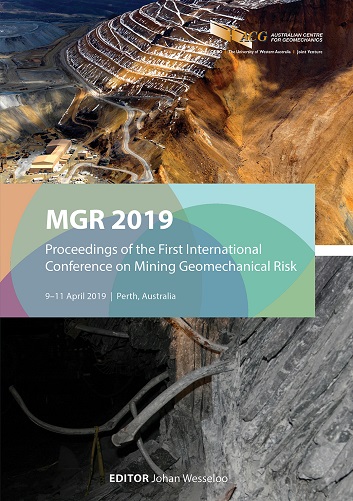A measured risk approach to managing the design and operation of a tailings storage facility

|
Authors: Coffey, JP; Plunkett, JD |
DOI https://doi.org/10.36487/ACG_rep/1905_10_Coffey
Cite As:
Coffey, JP & Plunkett, JD 2019, 'A measured risk approach to managing the design and operation of a tailings storage facility', in J Wesseloo (ed.), MGR 2019: Proceedings of the First International Conference on Mining Geomechanical Risk, Australian Centre for Geomechanics, Perth, pp. 205-218, https://doi.org/10.36487/ACG_rep/1905_10_Coffey
Abstract:
Tailings storage facility (TSF) design has long been based on deterministic limits. By extension, the TSF owner accepts a Probability of Failure (PF) associated with these deterministic limits which are assessed against ‘industry norms’ with respect to investigation/analysis and design assumptions related to the operation of the facility. If the Probability of Failure of a design that is derived in this way is taken as the likelihood related to the tolerable risk limit, it follows that the same, or a lower PF, should be maintained during operations. Examples of operational controls include pond management and inspections/monitoring. Upset conditions arise when operational controls are not being implemented. Therefore, by comparing the calculated PF of the TSF complying with the design assumptions and the PF for the same TSF in an upset condition, the required PF of operational controls can be estimated. This concept assists the TSF owner in determining what is required to safely operate the facility and communicate the geotechnical risk to all stakeholders. By extension, scenarios where a TSF owner cannot achieve the required PF of operational controls can be addressed with: 1. Greater rigor applied to operational controls. 2. Addition of more operational controls. 3. A change to the design assumptions, where the timing of the project allows. This method provides a measured approach to risk management in the design and operational phases, without a TSF owner having to quantify an acceptable risk tolerance. Instead, the design is based upon widely accepted practice and industry/business accepted safety, economic and environmental risk levels. Subsequently, the design PF can be calculated and then applied as a benchmark for operations. This approach serves to reduce uncertainty through alignment of the design and operation phases. The concept is explored for three different tailings storage methods: upstream raised TSF, downstream raised TSF, and impoundment by mine waste dumps, to estimate how sensitive each storage method is to the type and effectiveness of operational controls implemented by the dam owner.
Keywords: tailings storage facility, operation, Probability of Failure, control
References:
Australian National Committee on Large Dams 2012, Guidelines on Tailings Dams – Planning, Design, Construction, Operation and Closure, Australian National Committee on Large Dams, Hobart.
Boshoff, J 2015, ‘Responsible tailings management’, Proceedings of Tailings and Mine Waste Management for the 21st Century, The Australasian Institute of Mining and Metallurgy, Melbourne.
Bruce, IG & Oboni, F 2002, ‘Risk-management process for tailings control’, Mining Engineering, vol. 54, no. 10, pp. 14–17.
Duncan, JM 2000, ‘Factors of safety and reliability in geotechnical design’, Journal of Geotechnical and Geoenvironmental Engineering, pp. 307–316.
Geoprofessional Business Association 2018, Proposed Best Practices for the Engineer of Record (EOR) For Dams, Geoprofessional Business Association
International Committee on Large Dams 2001, Bulletin 121: Tailings Dams: Risk of Dangerous Occurrences: Lessons Learnt from Practical Experiences, International Committee on Large Dams, Paris.
ICMM 2016, Preventing Catastrophic Failure of Tailings Storage Facilities, ICMM, London.
Martin, TE & Davies, MP 2002, Trends in the Stewardship of Tailings Dams, AGRA Earth & Environmental Limited, Burnaby.
The Mining Association of Canada 2017, A Guide to the Management of Tailings Facilities, 3rd edn, The Mining Association of Canada, Ottawa.
Morgenstern, NR, Vick, SG & Van Zyl, D 2015, Independent Expert Engineering Investigation and Review Panel: Report on Mount Polley Tailings Storage Facility Breach, viewed 7 February 2019,
Morgenstern, NR, Vick, SG, Viotti, CB & Watts, BD 2016, Fundão Tailings Dam Review Panel: Report on the Immediate Causes of the Failure of the Fundão Dam, viewed 7 February 2019,
Murray, L, McLeod, H & Suter, G 2010, ‘Effectiveness in risk assessment – a comparison of perceived and realised risk from project concept to construction and operation’, in AB Fourie & RJ Jewell (eds), Proceedings of the First International Seminar on the Reduction of Risk in the Management of Tailings and Mine Waste, Australian Centre for Geomechanics, Perth, pp. 217–228.
Rocscience Inc. 2017, Slide, version 7.0, computer software, Rocscience Inc., Toronto.
US Department of the Interior Bureau of Reclamation 2015, Best Practice in Dam and Levee Safety Risk Analysis, US Department of the Interior Bureau of Reclamation, Washington DC.
© Copyright 2025, Australian Centre for Geomechanics (ACG), The University of Western Australia. All rights reserved.
View copyright/legal information
Please direct any queries or error reports to repository-acg@uwa.edu.au
View copyright/legal information
Please direct any queries or error reports to repository-acg@uwa.edu.au
